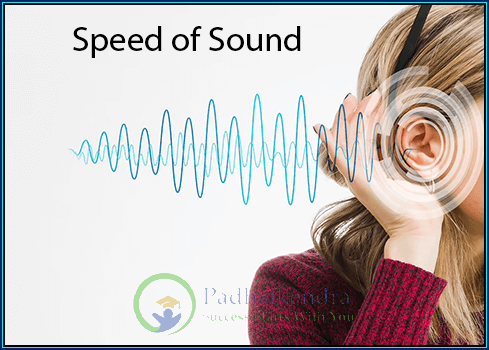The speed of sound is the distance that a sound wave travels in a given amount of time. The speed of sound depends on the properties of the medium through which it is traveling, such as its density and stiffness.
In air at sea level and at a temperature of 20 degrees Celsius (68 degrees Fahrenheit), the speed of sound is approximately 343 meters per second (about 1,125 feet per second or 768 miles per hour). However, the speed of sound can vary depending on the temperature, humidity, and pressure of the air.
 In other materials, such as water or steel, the speed of sound is different than in air. For example, in water, the speed of sound is approximately 1,482 meters per second (about 4,828 feet per second or 3,315 miles per hour), which is much faster than the speed of sound in the air.
In other materials, such as water or steel, the speed of sound is different than in air. For example, in water, the speed of sound is approximately 1,482 meters per second (about 4,828 feet per second or 3,315 miles per hour), which is much faster than the speed of sound in the air.
The speed of sound is an important concept in many areas of science and engineering, including acoustics, music, and aviation. It is used, for example, to calculate the time it takes for a sound wave to travel from its source to a receiver, and to design structures and machines that can withstand the forces generated by sound waves.
Speed of sound FAQs
The speed of sound refers to the rate at which sound waves propagate through a medium, such as air, water, or solids. It represents how quickly sound travels from a source to a receiver.
The speed of sound varies depending on the medium through which it travels. In dry air at sea level and room temperature (approximately 20°C or 68°F), the speed of sound is approximately 343 meters per second (m/s) or 767 miles per hour (mph).
Several factors influence the speed of sound, including temperature, density, and elasticity of the medium. Generally, sound travels faster in denser and more elastic materials, while higher temperatures increase the speed of sound.
Yes, the speed of sound changes with altitude due to variations in air temperature and density. In general, the speed of sound decreases with increasing altitude, as the air becomes less dense and cooler.
The speed of sound varies depending on the properties of the medium. For example, sound travels faster in solids compared to liquids, and faster in liquids compared to gases. This is because solids have a higher density and greater elasticity, allowing sound waves to propagate more quickly.
The speed of sound can be measured using various methods, such as time-of-flight measurements or resonance techniques. In some cases, devices like sonar or radar are used to indirectly determine the speed of sound.
The speed of sound in kilometers per hour is approximately 1,236 kilometers per hour (km/h).
The speed of sound varies depending on the medium through which it travels. In dry air at sea level and room temperature, sound travels at approximately 343 meters per second (m/s) or 1,235 kilometers per hour (km/h).
In a vacuum, such as outer space, sound waves cannot propagate as there is no medium to transmit them. Therefore, sound does not travel in a vacuum, and thus, the speed of sound in a vacuum is undefined.
The speed of sound in air depends on the temperature of the air. At sea level and at a temperature of approximately 20°C (68°F), the speed of sound in dry air is around 343 meters per second (m/s) or 1,235 kilometers per hour (km/h). However, the speed of sound in air can vary with changes in temperature, humidity, and pressure.
 In other materials, such as water or steel, the speed of sound is different than in air. For example, in water, the speed of sound is approximately 1,482 meters per second (about 4,828 feet per second or 3,315 miles per hour), which is much faster than the speed of sound in the air.
In other materials, such as water or steel, the speed of sound is different than in air. For example, in water, the speed of sound is approximately 1,482 meters per second (about 4,828 feet per second or 3,315 miles per hour), which is much faster than the speed of sound in the air.




